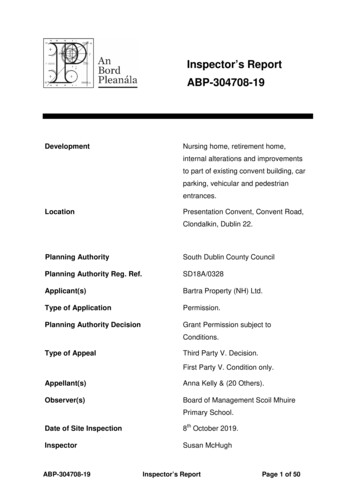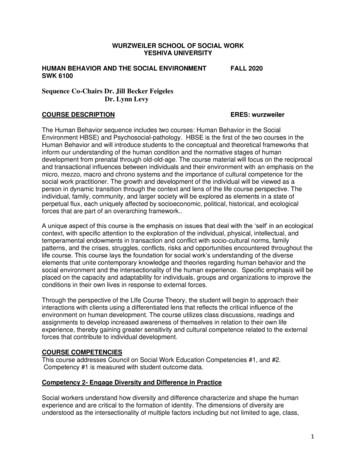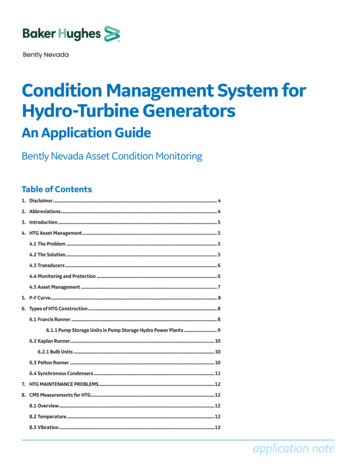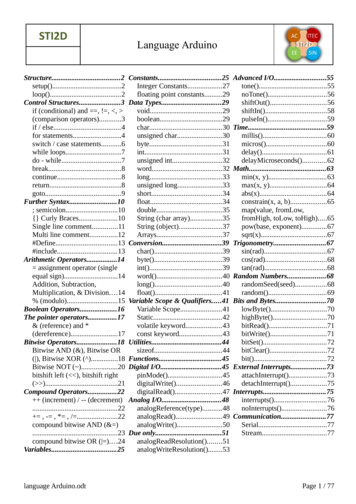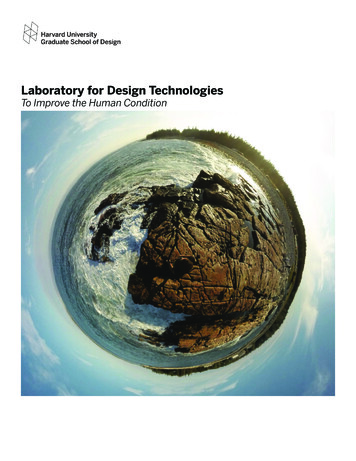
Transcription
Laboratory for Design TechnologiesTo Improve the Human Condition
Harvard University’s Graduate School of DesignThe Harvard University Graduate School of Design (GSD) has a rich legacy of design leadership and innovation,pushing the frontiers of knowledge and research across all design disciplines for more than 80 years. As thelargest and most comprehensive design school worldwide, the GSD offers programs in architecture, landscapearchitecture, urban planning and design, design studies, and design engineering. And as a global leader in eachof these fields, the GSD is redefining design as a critical response to increasingly complex issues faced bypeople, cities, and ecologies, across the United States and around the world.The GSD’s method of design education involves transdisciplinary collaboration across all of the School’sdepartments and programs, as well as with other schools and units at Harvard. It is through this cross-practicethat the GSD fosters a deep connection between design and other academic fields, which is reflected in the jointdegree programs with the Harvard John A. Paulson School of Engineering and Applied Sciences, the HarvardT.H. Chan School of Public Health, the John F. Kennedy School of Government, and the Harvard Law School.The GSD is educating leaders in design, research, and scholarship who will directly impact and improve the builtenvironment to create a resilient, just, and beautiful world, now and in the future.Laboratory for Design TechnologiesTechnology is accelerating profound changes throughout society, affecting how we live, work, produce, build,and think. The ubiquity of data and computational power impacts all systems—from mobility and health togovernment and construction. The Laboratory for Design Technologies (LDT) at the Harvard Graduate School ofDesign is a collaborative platform that investigates the challenges and opportunities at the intersection ofdesign technology and the built environment. It advances design as a catalyst of change and leveragesinnovative research methods to understand the architecture of complex issues.LDT Research TracksThe Laboratory for Design Technologies has established a collaborative platform to pursue work byfaculty in multiple research units.Material Processes and Systems GroupMartin Bechthold DDes ’01The Material Processes and Systems Group (MaP S) is a research lab that takes materials as a starting pointfor a broad set of research investigations that involve computation, robotics, and material science. MaP Sadvances the aesthetic and functional agenda of materials in the built environment. The group, which evolvedfrom the previously established Design Robotics Group, looks at materiality as a starting point for designresearch, with a special interest in robotic and computer numerically controlled (CNC) fabrication processes, aswell as small-scale work on nano materials.Geometry LabAndrew Witt MArch ’07, MDes ’02The Geometry Lab researches the intersection of design and the science of shape and form, aided bycomputational tools and design intuition. This Lab combines computational, formal, architectural, and historicalresearch in a heterogeneous yet synthetic agenda. The objectives of the Lab are to produce and disseminatenew knowledge, to generate broad, scalable solutions to big problems, and to explore the associated culturaland human implications.
The Responsive Environments and & Artifacts Lab (REAL Lab)Allen Sayegh MDes ’96The Responsive Environments and Artifacts Lab (REAL) is a research lab that pursues the design of digital,virtual, and physical worlds as an indivisible whole. It recognizes the all-pervasive nature of digital informationand interaction at scales ranging from our bodies to the larger urban contexts we occupy and theinfrastructures that support them. REAL takes an interdisciplinary look at the design of the built environmentfrom the lens of technologically augmented experiences, with a strong focus on the sustainability andlongevity of technology. Putting the human being at the center and forefront, from the micro (bodily sensors,smart product design, augmented interfaces) to the macro (interactive buildings, information infrastructures,communication frameworks), researchers at REAL examine the emerging ways in which technology fuses intothe ways we live, work, and play.Urban StackElizabeth Christoforetti MArch ’09Carole VoulgarisThe Urban Stack Lab (USL) explores the impact and opportunities presented by the emergence of scalablesystems in the built environment and is building and testing productive overlaps between the digital, social, anddesign processes that shape urban form and civic futures in 21st century urban places. Faculty are developingtechnologies that embrace the complexity of social infrastructures and market dynamics to produce newmodes of design practice. The persistent and growing challenge of housing supply and quality is a primary focusof current USL research.Designing ChangeSince its inception in 2018, the Laboratory for Design Technologies has generated ideas with remarkablepotential:The Future of Air Travel focus project, which encompasses faculty and researchers from three LDT researchunits (REAL, MaP S, and the Geometry Lab) is currently in year two of it’s three-year research project. Facultyare examining the relationships between technology, mobility, the environment, and human experience. Projectoutput includes ON FLYING: A Toolkit, a catalog of tactics deployed by airports and airlines to guide passengersand rethink the human experience of air travel, and the Atlas of Urban Air Mobility, a body of research that willinform the development of an interactive tool for assessing multimodal scenarios.Faculty and researchers from MaP S and Urban Stack Lab are teaming up to launch a new focus project, Work4.0, which will investigate the concept of hybrid work – a combination of the digital and the physical – as the“quintessential condition of contemporary life.” By incorporating architectural, scientific, and engineeringresearch methods, the LDT team will focus on a set of research questions within two specific domains: theUrban Dimension, and the Workspace.A High Visibility PartnershipThe GSD invites leading companies to engage in LDT by becoming members of the Industry Advisors Group, aunique philanthropic network where experts from industry and the public sector join with faculty andresearchers from the GSD and the greater Harvard community to shape the future of the built environmentthrough innovative design research. The real-world perspective of the Industry Advisors helps to bridge the gapbetween discovery and the advancement of ideas and transforms inspiration to activation. Operating from aplatform of shared knowledge, industry leaders work with a committed group of internal and externalstakeholders to accelerate the development of new products, processes, and systems.
The Industry Advisors Group members help to guide forward-looking projects in areas such as artificialintelligence and machine learning, adaptive material systems, multidimensional computational simulations andspatial analysis, and multimedia design interfaces. It is a vigorous forum for thought leaders in fields includingconstruction, fabrication, material production, design and engineering, real estate, technology, government, andinternational development. Alongside faculty, members focus on broad-based, strategic research questions—ata fraction of the cost that such high-risk, high-reward investigations would require if conducted at in-house corporate R&D facilitates. Participation represents a low-risk investment that could yield visionary results.Some participants in the Industry Advisors Group may opt to fund timely research on critical topics by enteringinto separate agreements at an additional cost. In 2019, the School convened experts from multiple sectors foran ambitious, three-year study on “The Future of Air Travel.” The group is working collaboratively to reimagineair travel at both the human and system scale. These creative partnerships around a series of “focus projects”will give us a better chance of finding solutions to the complex challenges we face as a global community – issues that no single academic discipline, business sector, or organization can address alone. Please join us in thisimportant work.Make It HappenFunding Levels Corporate membership begins at 225K, payable over three years, at 75K per year. Tofund a focus projects, such as “The Future of Air Travel,” the commitment level is 375K,payable over three years, at 125K per year.Design Firm membership begins at 150K, payable over three years, at 50K per year.Opportunities Access to a shared platform for design technology research.Access to LDT newsletters and publications.Participation in bi-annual LDT meetings and workshops, and a series of virtual sessions.Facilitated access to world-class faculty, students, and a broad network of internal andexternal stakeholders.Invitations to lectures, exhibitions, receptions, and tours on campus and around the globe.Enhanced opportunities for student recruitment.
Laboratory for Design Technologies FacultyJOANNA AIZENBERGAmy Smith Berylson Professor of Material Sciences at Harvard John A. Paulson School ofEngineering and Applied SciencesProfessor of Chemistry and Chemical Biology in the Department of Chemistry andChemical BiologyMARTIN BECHTHOLD DDes ’01Kumagai Professor of Architectural TechnologyDirector, Doctor of Design ProgramCo-Director of Master in Design Engineering ProgramAssociate Faculty, Wyss Institute for Biologically Inspired EngineeringDirector, Material Processes and Systems (MaP S) GroupELIZABETH CHRISTOFORETTI MArch ’09Assistant Professor in Practice of ArchitectureJOSE LUIS GARCÍA DEL CASTILLO Y LÓPEZ MDes ’13, DDes ’19Lecturer in Architectural TechnologyJONATHAN GRINHAM DDes ’18Lecturer in Architecture and Research AssociateCHUCK HOBERMANPierce Anderson Lecturer in Design EngineeringALLEN SAYEGH MDes ’96Associate Professor in Practice of Architectural TechnologyDirector, Responsive Environments & Artifacts Lab (REAL)CAROLE VOULGARISAssistant Professor of Urban PlanningANDREW WITT MArch ’07, MDes ’02Associate Professor in Practice of ArchitectureDirector, Geometry Lab
The Graduate School of Designeducates leaders in design,research, and scholarshipto make a resilient, just,and beautiful world.
The Harvard University Graduate School of Design (GSD) has a rich legacy of design leadership and innovation, pushing the frontiers of knowledge and research across all design disciplines for more than 80 years. As the largest and most comprehensive design school worldwide, the GSD offers programs in architecture, landscape



